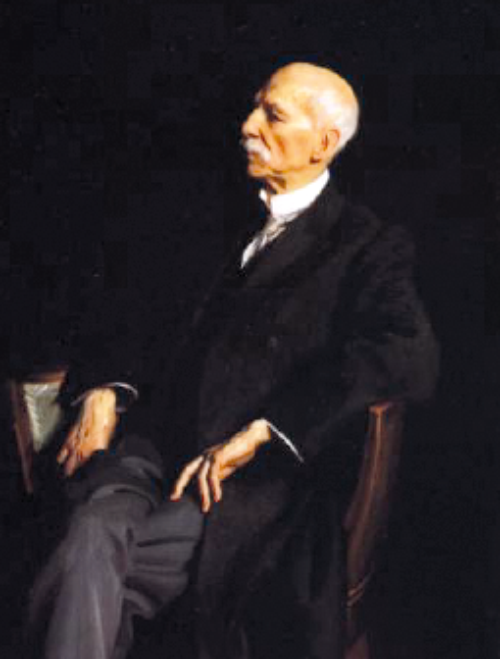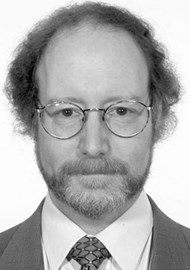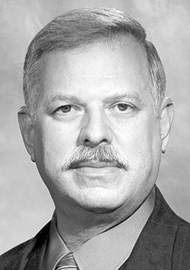Two laryngological authorities trace the history of laryngology, from ancient Rome to the modern day.
The structure of the vocal folds was a matter of conjecture until the renaissance when anatomists such as Andreas Vesalius and Julius Casserius demonstrated the gross anatomy [1]. That said, voice, oratory and singing have been of great interest at least since the days of the ancient Greeks. Even in ancient Sparta, where physical prowess was emphasised, singing had a major role in day-to-day life [2]. Subjective vocal qualities were commented upon by Roman teachers of oratory.

Manuel Garcia, age 100, by John Singer Sargent RA.
This picture is displayed in the Duke’s Hall, Royal Academy of Music, London.
Scientists and teachers of voice were hampered by the inability to visualise the true vocal folds in vivo directly [3]. It was not until the 19th century that methods of visualisation became available. Philipp Bozzini (1807) has been credited for the development of a primitive laryngoscope, Manuel Garcia (1854) for mirror visualisation of the vocal fold, Johann Czermak and Morell Mackenzie for using the mirror in clinical practice. Theodor Billroth (1873) undertook his first total laryngectomy, and his assistant Carl Gussenbauer inserted an early neopharynx / artificial larynx for this patient in early 1874 thereby allowing some element of post laryngectomy speech. Max Joseph Oertel developed an early stroboscope in1878, and published his seminal work in 1895 [4].
“The pseudo-membrane that was almost pathognomonic of diphtheria was associated with airway obstruction and was the direct cause of tens of thousands of airway deaths in children, as well as of tracheotomies in the late 19th and early 20th centuries.”
In the 19th century, laryngology developed primarily as a response to infectious diseases. The pseudo-membrane that was almost pathognomonic of diphtheria was associated with airway obstruction and was the direct cause of tens of thousands of airway deaths in children, as well as of tracheostomies in the late 19th and early 20th centuries. Joseph O’Dwyer (1885) published a report of his use of a cannula that was inserted into the larynx and circumvented airway death during the acute phase of this illness. This tube became the beginning of intubation devices [5].
In the early 20th century, particularly after the First World War, tobacco became widely accepted and used by the population of Western Europe and America. Its use was accompanied by a marked increase in cancer of the lung and vocal fold paralysis. Initially, this was predominantly a disease of males; but in the second half of the 20th century it also became a disease of females as smoking among women increased. During this time, techniques to improve voice and laryngeal closure developed in the medical profession in association with speech-language pathologists.
Different materials for vocal fold medialisation were championed [3,6] beginning with Wilhelm Brunings’ use of paraffin in 1911. Paraffin proved an unacceptable material for injection, and other materials such as bone, penicillin in oil, tantalum and then glycerin in oil were tried. Godfrey Arnold popularised the use of Teflon in glycerin to be injected into the larynx [7]. Teflon became the most commonly used material throughout much of the second half of the 20th century for this purpose. Unfortunately, it became clear that a granulomatous response was developed by the larynx against the Teflon, and its use has been discontinued. Charles Ford experimented with collagen as an injectable material in the 1980s [8] and some centres still use this material. More recently injectable materials such as autologous fat [9], hyaluronic acid and calcium hydroxylapatite have become used more regularly for vocal fold palsies and atrophy.
“Acoustical analysis, aerodynamics, signal processing, mathematical modelling, high speed imaging and artificial intelligence are all newer fields being applied in an attempt to better understand vocal function.”
External procedures on the larynx developed alongside injection. Early procedures were described (1915) by Erwin Payr [10]. Then, in 1974 Nobuhiko Isshiki [11] developed and popularised a series of external laryngeal surgical procedures for compressing, stretching or relaxing the vocal folds that are still of considerable interest and have been modified by many newer laryngologists, for example Steven Zeitels [3,6,12].
Hans von Leden and Godfrey Arnold coined the term phonosurgery in the early 1960s. Visualisation of the larynx improved markedly with the development of fibre optics in the second half of the 20th century. This technology was shortly thereafter applied to laryngeal visualisation using a tube inserted through the nose, as pioneered by Wilbur James Gould, who also founded the (American) Voice Foundation in 1969.
In part through Dr Gould’s efforts to sponsor a multidisciplinary approach to the voice, the field has burgeoned in the past 50 years. Upon his death (in 1994) Robert Thayer Sataloff took over as Chairman of the Voice Foundation. The ensuing history involves too many individuals to name. The dedication and continued interest from clinicians and specialists of diverse backgrounds germane to voice and vocal tract problems have led to this explosion of knowledge.
Anatomists, physiologists and cellular biologists are continuing to develop approaches to laryngeal structure, initially gross, then molecular, then genetic, and to the biomechanics of the larynx and of the vocal tract, as well as the neurological substrates and pathways underlying voicing. Acoustical analysis, aerodynamics, signal processing, mathematical modelling, high speed imaging and artificial intelligence are all newer fields being applied in an attempt to better understand vocal function.
“Our clinical work is informed by the continued efforts of physicists, mathematicians, biologists, geneticists, neuroscientists, epidemiologists and others.”
The last two decades in particular have shown us the necessity of patient-oriented and patient-based assessments as the centre-point of clinical and basic science investigations, as well as the crucial importance of evidence-based therapy. Clinicians involved in care of patients with voice problems now tend to approach management in teams, as evidenced by the British Voice Association’s database of approximately 100 multidisciplinary voice clinics in the British Isles. These teams of specialists routinely use pathways incorporating patient-based quality-of-life questionnaires, perceptual auditory assessments, and objective acoustical and aerodynamic analyses in order to offer patients the best available treatment and outcomes assessment.
In 2005, the authors noted, “It appears that the evaluation and development of sports medicine and sports science is an appropriate analogy for voice” [2]. With the Winter Olympics and Paralympics just over at the time of the writing of this article, this statement seems even more apt today. We continue to approach voice issues in professional, and especially in elite, voice users in this fashion, regularly involving multidisciplinary teams in their care, including speech language pathologists, osteopaths and physiotherapists, nurse clinicians, singing and acting pedagogists and coaches. Our clinical work is informed by the continued efforts of physicists, mathematicians, biologists, geneticists, neuroscientists, epidemiologists and others. There are more grants supporting research in voice-related subjects from the NIH, the Wellcome Institute, from industry and other sources than ever before.
The future is very bright indeed for laryngology, voice research and patient- centered care, as is the advancing state-of- the-art in clinical care of voice patients.
References
1. Von Leden H. A cultural history of the larynx and voice. In: Sataloff RT. Professional Voice: The Science and Art of Clinical Care, Fourth Edition. San Diego, USA; Plural Publishing; 2017:9-88.
2. Rubin JS, Sataloff RT. Voice Horizons. In: Sataloff RT. Professional Voice: The Science and Art of Clinical Care, Fourth Edition. San Diego, USA; Plural Publishing; 2017:1815-28.
3. Zeitels SM. The History and Development of Phonomicrosurgery. In: Sataloff RT. Professional Voice: The Science and Art of Clinical Care, Fourth Edition. San Diego, USA; Plural Publishing; 2017:1347-1478.
4. Oertel MJ. Ueber eine neue laryngostroboscopische untersuchungsmethode. Munchen Med Woknschr 1895;42:233-6.
5. Weir N. Otolaryngology, an illustrated history. London, UK; Butterworths; 1990.
6. Sataloff RT, Chowdhury F, Portnoy J, Hawkshaw MJ, Joglekar S. Surgical Techniques in Otolaryngology – Head and Neck Surgery: Laryngeal Surgery. New Delhi, India; Jaypee Brothers Medical Publishers; 2014.
7. Arnold GE. Vocal rehabilitation of paralytic dysphonia. IX. Technique of intracordal injection. Arch Otolaryngol Head Neck Surg 1962;76:358.
8. Ford CD and Bless DM. Clinical experience with injectable collagen for vocal fold augmentation. Laryngoscope 1986;96(8):863-9.
9. Mikaelian DO, Lowry LD, Sataloff RT. Lipoinjection for unilateral vocal cord paralysis. Laryngoscope 1991;101(5):465-8.
10. Payr E. Plastik am schildknorpel zur Behebung der Folgen einseitiger Stimmbandlahmung. Dtsch Med Wochensch 1915;43:265-70.
11. Isshiki N, Morita H, Okamura H, Hiramoto M. Thyroplasty as a new phonosurgical technique. Acta Otolaryngol 1978;104:555-8.
12. Zeitels SM. Vocal fold medicalization: injection and laryngeal framework surgery. In: Rubin JS, Sataloff RT, Korovin GS (Eds.). Diagnosis and Treatment of Voice Disorders, Fourth Edition. San Diego, USA; Plural Publishing; 2014:833-46.





